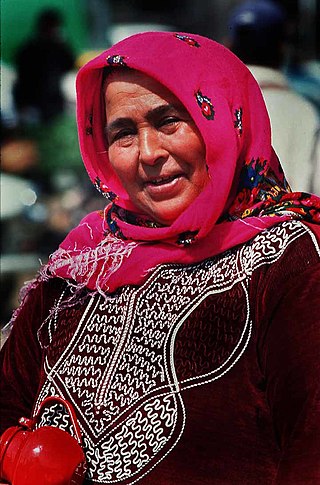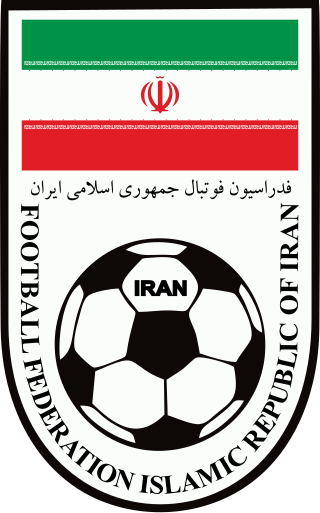Related Research Articles

In modern usage, hijab generally refers to various head coverings conventionally worn by many Muslim women. While a hijab can come in many forms, it often specifically refers to a headscarf, wrapped around the head, covering the hair, neck and ears, but leaving the face visible. The use of the hijab has been on the rise worldwide since the 1970s and is viewed by many Muslims as expressing modesty and faith. There is a consensus among Islamic religious scholars that covering the head is either required or preferred, though some Muslim scholars and activists argue that it is not mandated. According to the Harvard University Pluralism Project: "Some Muslim women cover their head only during prayer in the mosque; other Muslim women wear the hijab; still others may cover their head with a turban or a loosely draped scarf."

A chādor, also variously spelled in English as chadah, chad(d)ar, chader, chud(d)ah, chadur, and naturalized as, is an outer garment or open cloak worn by many women in the Persian-influenced countries of Iran, Afghanistan, Pakistan, and to a lesser extent Tajikistan, as well as in Shia communities in Iraq, Bahrain, and Qatif in Saudi Arabia in public spaces or outdoors.
Islamic clothing is clothing that is interpreted as being in accordance with the teachings of Islam. Muslims wear a wide variety of clothing, which is influenced not only by religious considerations, but also by practical, cultural, social, and political factors. In modern times, some Muslims have adopted clothing based on Western traditions, while others wear modern forms of traditional Muslim dress, which over the centuries has typically included long, flowing garments. Besides its practical advantages in the climate of the Middle East, loose-fitting clothing is also generally regarded as conforming to Islamic teachings, which stipulate that body areas which are sexual in nature must be hidden from public view. Traditional dress for Muslim men has typically covered at least the head and the area between the waist and the knees, while women's islamic dress is to conceal the hair and the body from the ankles to the neck. Some Muslim women also cover their face. However, other Muslims believe that the Quran does not mandate that women need to wear a hijab or a burqa.

The Football Federation Islamic Republic of Iran is the governing body for football in Iran. It was founded in 1920, and has been a member of FIFA since 1948. It is also a member of the Asian Football Confederation.
Throughout history, women in Iran have played numerous roles, and contributed in many ways, to Iranian society. Historically, tradition maintained that women be confined to their homes to manage the household and raise children. During the Pahlavi era, there was a drastic social change towards women's desegregation such as ban of the veil, right to vote, right to education, equal salaries for men and women, and the right to hold public office. Women were active participants in the Islamic Revolution. Iran's constitution, adopted after the Islamic Revolution in 1979, proclaims equality for men and women under Article 20, while mandating legal code adhering to Sharia law. Article 21 of the constitution as well as a few parliament-passed laws give women rights such as being allowed to drive, hold public office, and attend university but not wearing a veil in public can be punished by law; and when in public, all hair and skin except the face and hands must be covered. However, this is often not enforced; notably in recent years, Iranian women have started a number of groups to rebel against the government's oppressive policies and reclaim their independence and rights.
Islamic feminism is a form of feminism concerned with the role of women in Islam. It aims for the full equality of all Muslims, regardless of gender, in public and private life. Islamic feminists advocate women's rights, gender equality, and social justice grounded in an Islamic framework. Although rooted in Islam, the movement's pioneers have also utilized secular, Western, or otherwise non-Muslim feminist discourses, and have recognized the role of Islamic feminism as part of an integrated global feminist movement.
During the late 20th and early 21st centuries in Iran, women's rights have been severely restricted, compared with those in most developed nations. The World Economic Forum's 2017 Global Gender Gap Report ranked Iran 140, out of 144 countries, for gender parity. In 2017, in Iran, females comprised just 19% of the paid workforce, with seven percent growth since 1990. In 2017, the Georgetown Institute for Women, Peace and Security (WPS) Index ranked Iran in the bottom tercile of 153 countries. Compared to other South Asian regions, women in Iran have a better access to financial accounts, education, and cellphones. Iran was ranked 116, out of the 153 countries, in terms of legal discrimination against women.
The Women's Islamic Games, also called the Muslim Women's Olympics, were an international multi-sport event started in 1993. The event was organised by the Islamic Federation of Women's Sport. Muslim women of all nationalities were allowed to take part in the Games.
Religious clothing is clothing which is worn in accordance with religious practice, tradition or significance to a faith group. It includes clerical clothing such as cassocks, and religious habit, robes, and other vestments. Accessories include hats, wedding rings, crucifixes, etc.

Various styles of head coverings, most notably the khimar, hijab, chador, niqab, paranja, yashmak, tudong, shayla, safseri, carşaf, haik, dupatta, boshiya and burqa, are worn by Muslim women around the world, where the practice varies from mandatory to optional or restricted in different majority Muslim and non-Muslim countries.

Majid Tavakoli is an Iranian student leader, human rights activist and political prisoner. He used to be a member of the Islamic Students' Association at Tehran's Amirkabir University of Technology, where he studied shipbuilding. He was arrested at least three times by the Iranian Ministry of Intelligence, during the student protests over the disputed Presidential Election of 2009. In response to allegations that he cross-dressed as a disguise to avoid arrest, a campaign protesting his imprisonment featured men posting photos of themselves wearing hijab.

World Hijab Day is an annual event founded by Nazma Khan in 2013, taking place on 1 February each year in 140 countries worldwide. Its stated purpose is to encourage women of all religions and backgrounds to wear and experience the hijab for a day and to educate and spread awareness on why hijab is worn. Nazma Khan said her goal was also to normalize hijab wearing.
Women in Somalia form a key part of Somali society, with clearly defined and important roles in the family and structure. This includes Somali women in Somaliland, a self-declared republic that is internationally recognized as an autonomous region of Somalia. From the time of Ismail Urwayni's proselytizing in 1890, until the Dervish State's defeat by British air bombardment in 1920, women in the strip of land from Jidali, Sanaag in the north, to Beledweyne in the south were referred to as Darawiishaad (plural) or Darwiishad (singular).
My Stealthy Freedom is an online movement that was started in 2014 by Masih Alinejad, an Iranian-born journalist and activist based in the United Kingdom and the United States. This movement started as a Facebook page, called My Stealthy Freedom, where women in Iran post photos of themselves without scarves, as a protest against the compulsory hijab laws in the country. By the end of 2016, the page has surpassed 1 million Facebook likes. The initiative has received wide international and national coverage, and has been both praised and criticized.

On 8 January 1936, Reza Shah of Iran (Persia) issued a decree known as Kashf-e hijab banning all Islamic veils, an edict that was swiftly and forcefully implemented. The government also banned many types of male traditional clothing. The ban was only enforced for a period of five (5) years (1936-1941), however, since then, the hijab in Iran has been a mandatory hallmark of the Islamic Republic for 44 years. One of the enduring legacies of Reza Shah has been turning dress into an integral problem of Iranian politics.

The Guidance Patrol or morality police is an Islamic religious police force and vice squad in the Law Enforcement Command of the Islamic Republic of Iran. The Guidance Patrol enforce Sharia–Islamic law—per laws in Iran; this is most often the enforcement of Islamic dress code, such as ensuring women in the country wear hijabs. The Guidance Patrol was formed in 2005 as a successor organisation to the older Islamic Revolution Committees, and reports to the Supreme Leader.

Modern Muslim female athletes have achieved success in a variety of sports, including volleyball, tennis, association football, fencing, and basketball. In the 2016 Summer Olympics, fourteen women from Muslim-majority countries won medals, participating in a wide range of sports.

Islamic feminist views on dress codes include views on issues surrounding women's dress codes in Islam, especially on the hijab and niqāb.

On International Women's Day on March 8, 1979, a women's march took place in Tehran in Iran. The march was originally intended to celebrate the International Women's Day, but transformed into massive protests against the changes taking place in women's rights during the Iranian revolution, specifically the introduction of mandatory hijab (veiling), which had been announced the day before. The protests lasted for six days, from 8 March to 14 March 1979, with thousands of women participating. The protests were met with violence and intimidation by pro-Khomeini Islamist forces.

Hijab in Iran, the traditional head covering worn by Muslim women for modesty for centuries, have been practiced as a compulsion supported by law in Iran after the 1979 revolution. In the 1920s, a few women started to appear unveiled. Under Reza Shah, it was discouraged and then banned in 1936 for five years. Under Reza Shah's successor, Mohammad Reza Pahlavi, hijab was considered "backward" and rarely worn by upper and middle-class people. Consequently, it became a symbol of opposition to the shah in 1970s, and was worn by women who previously would have been unveiled.
References
- ↑ "Men in Iran are wearing hijabs in solidarity with their wives - here's why" . The Independent. 2016-07-31. Archived from the original on 2022-05-12. Retrieved 2016-11-30.
- ↑ "The Hijab of Men – Islamic Insights". www.islamicinsights.com. 6 October 2009. Retrieved 2016-11-30.
- ↑ "These Iranian men in hijabs are taking a stand for women and against moral policing". The Indian Express. 2016-07-31. Retrieved 2016-11-30.
- ↑ "Iranian men don hijab to challenge strict veil law". ABC News. 2016-08-03. Retrieved 2016-11-30.